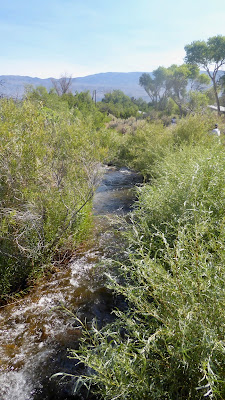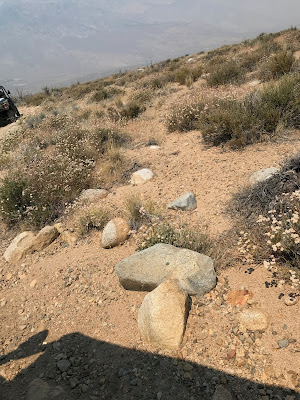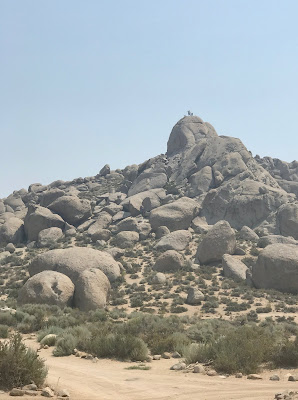We were glad we didn't skip the Eastern California Museum in Independence, which proved to be a many-faceted gem.
then moved into the Engine House to see #18 steam engine, the Slim Princess, that volunteers had impeccably restored to working order.
From there we wandered through "Little Pine Village," a tree-shaded collection of early settlers' buildings from a multi-seater outhouse to post office.
Next we explored the Mary de Decker garden of native plants.
Already impressed, we were awed by the variety of materials in the museum itself, first and foremost the collection of some 400 Paiute and Panamint Shoshone baskets, utilitarian and trade.
The trade baskets were jewels of design, those woven for use - up to 47 to 50 stitches per square-inch - were virtually waterproof.
We could have spent the better part of a day wandering through exhibits of the life and characters that inhabited the area.
Where else would you find the story of mountaineer Norman Clyde, nicknamed the "pack with legs" for the 80-pound backpack he carried ascending the peaks within the Sierra Nevadas?

Or a suit worn by Amelia Earhart, whose husband found refuge here after her disappearance?
Don't miss this remarkable, and free, gem.
The drive up to Mount Whitney Portal at an altitude of 8,360 feet is another don't miss. From the trailhead behind the Portal you will have to hike and climb another 6,044 feet through wilderness to reach the top of the highest mountain in the continental United States.
For most of us, the Portal with Lone Pine Creek Falls, picnic grounds, store and diner is entertaining enough. The pancakes, promoted as the world's largest, are another memorable sight and taste.
Why the big pancakes? Story is that three kids stopped their bikes, came in and asked for the "cheapest, biggest thing to eat you have." They caught on.
 |
| Doug Thompson |
There were roads and sometimes we stayed on them when we went off-roading with Randy and Susan Gillespie, owners of Off Road Rentals.
Donning our helmets and settling into a Yamaha Viking UTV, we headed into the Tungsten Hills mining area of Buttermilk Country that abuts the John Muir Wilderness.
Up, bounce, jerk, down, bang, twist, repeat. With variations in order, this was the tempo throughout our rough and rocky ride.
From the late 1800s until the 1930s, this area was pocked with tungsten mines, from the world's largest to smaller efforts, plus a few gold digs. In 1980 mining in the area was ruled illegal.
According to Randy, there's still tons of tungsten to be had, but demand has lessened for the second-hardest element known to man with the highest melting point - 6125 degrees F - used to harden metals for everything from tools to armaments and projectiles to electronics.
We stopped for a picnic lunch amid the boulders of Buttermilk Country which offered a bit of shade in the otherwise treeless area.

We had never heard of boulder climbing but this is where you come to do it.
We looked back at photos we had taken and were dismayed by how badly the increasing haze overlaying this usually smog-free area affected their clarity.
The devastating fires engulfing the Sierras were coming closer. Did not bode well for images in Mammoth Lakes, our next stop.
























No comments:
Post a Comment